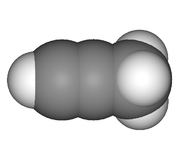- Methylacetylene
-
Methylacetylene 
 PropyneOther namesMethylacetylene
PropyneOther namesMethylacetylene
Methyl acetyleneIdentifiers CAS number 74-99-7 
ChEMBL CHEMBL116902 
Jmol-3D images Image 1 - CC#C
Properties Molecular formula C3H4 Molar mass 40.0639 g/mol Density 0.53 g/cm³ Melting point -102.7 °C, 170 K, -153 °F
Boiling point -23.2 °C, 250 K, -10 °F
 (verify) (what is:
(verify) (what is:  /
/ ?)
?)
Except where noted otherwise, data are given for materials in their standard state (at 25 °C, 100 kPa)Infobox references Methylacetylene (propyne) is an alkyne with the chemical formula CH3C≡CH. It is a component of MAPP gas along with its isomer 1,2-propadiene (allene), which is commonly used in gas welding. Unlike acetylene, methylacetylene can be safely condensed.[1]
Contents
Production and equilibrium with allene
Methylacetylene exists in equilibrium with allene, the mixture of methylacetylene and propadiene being called MAPD:
- H3CC≡CH ⇌ H2C=C=CH2
Keq = 0.22 (270 °C), 0.1 K (5 °C) MAPD is produced as a side product, often an undesirable one, by cracking propane to produce propene, an important feedstock in the chemical industry.[1] MAPD interferes with the catalytic polymerization of propene.
Use as a rocket fuel
Research by European space concerns into using light hydrocarbons with liquid oxygen as a relatively high performing liquid rocket propellant combination which would also be less toxic than the commonly used MMH/NTO (monomethylhydrazine/nitrogen tetroxide) systems, showed that propyne would be highly advantageous as a rocket fuel for craft intended for low Earth orbital operations. This conclusion was reached based upon a specific impulse expected to reach 370 s if oxygen is used as oxidizer, a high density and power density, and the moderate boiling point, which causes the chemical to present fewer problems in storage than for example a fuel that needs to be kept at extremely low temperatures. (See cryogenics.)
Organic chemistry
Propyne is a convenient three-carbon building block for organic synthesis. Deprotonation with n-butyllithium gives propynyllithium. This nucleophilic reagent adds to carbonyl groups, producing alcohols and esters.[2] Whereas purified propyne is expensive, MAPP gas can be used to cheaply generate large amounts of the reagent. [3]
External links
References
- ^ a b Peter Pässler, Werner Hefner, Klaus Buckl, Helmut Meinass, Andreas Meiswinkel, Hans-Jũrgen Wernicke, Günter Ebersberg, Richard Müller, Jürgen Bässler, Hartmut Behringer, Dieter Mayer, "Acetylene" in Ullmann's Encyclopedia of Industrial Chemistry Wiley-VCH, Weinheim, 2007. 10.1002/14356007.a01 097.pub2
- ^ Michael J. Taschner, Terry Rosen, and Clayton H. Heathcock (1990), "Ethyl Isocrotonate", Org. Synth., http://www.orgsyn.org/orgsyn/orgsyn/prepContent.asp?prep=CV7P0226; Coll. Vol. 7: 226
- ^ US patent 5744071, Philip Franklin Sims, Anne Pautard-Cooper, "Processes for preparing alkynyl ketones and precursors thereof", issued 1996-11-19
Categories:- Alkynes
- Fuel gas
- Rocket fuels
Wikimedia Foundation. 2010.
